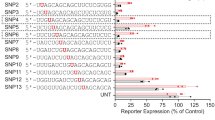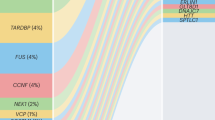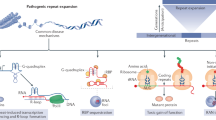Abstract
Allele-specific gene therapy aims to silence expression of mutant alleles through targeting of disease-linked single-nucleotide polymorphisms (SNPs). However, SNP linkage to disease varies between populations, making such molecular therapies applicable only to a subset of patients. Moreover, not all SNPs have the molecular features necessary for potent gene silencing. Here we provide knowledge to allow the maximisation of patient coverage by building a comprehensive understanding of SNPs ranked according to their predicted suitability toward allele-specific silencing in 14 repeat expansion diseases: amyotrophic lateral sclerosis and frontotemporal dementia, dentatorubral-pallidoluysian atrophy, myotonic dystrophy 1, myotonic dystrophy 2, Huntington’s disease and several spinocerebellar ataxias. Our systematic analysis of DNA sequence variation shows that most annotated SNPs are not suitable for potent allele-specific silencing across populations because of suboptimal sequence features and low variability (>97% in HD). We suggest maximising patient coverage by selecting SNPs with high heterozygosity across populations, and preferentially targeting SNPs that lead to purine:purine mismatches in wild-type alleles to obtain potent allele-specific silencing. We therefore provide fundamental knowledge on strategies for optimising patient coverage of therapeutics for microsatellite expansion disorders by linking analysis of population genetic variation to the selection of molecular targets.
Similar content being viewed by others
Log in or create a free account to read this content
Gain free access to this article, as well as selected content from this journal and more on nature.com
or
References
Martínez T, Wright N, López-Fraga M, Jiménez AI, Pañeda C : Silencing human genetic diseases with oligonucleotide-based therapies. Hum Genet 2013; 132: 481–493.
Seyhan AA : RNAi: a potential new class of therapeutic for human genetic disease. Hum Genet 2011; 130: 583–605.
Gibbs RA, Belmont JW, Hardenbol P et al: The International HapMap Project. Nature 2003; 426: 789–796.
Thorisson GA, Smith AV, Krishnan L, Stein LD : The International HapMap Project Web site. Genome Res 2005; 15: 1592–1593.
Ozdemir V, Rosenblatt DS, Warnich L et al: Towards an Ecology of Collective Innovation: Human Variome Project (HVP), Rare Disease Consortium for Autosomal Loci (RaDiCAL) and Data-Enabled Life Sciences Alliance (DELSA). Curr Pharmacogenomics Person Med 2011; 9: 243–251.
Du Q, Thonberg H, Wang J, Wahlestedt C, Liang Z : A systematic analysis of the silencing effects of an active siRNA at all single-nucleotide mismatched target sites. Nucleic Acids Res 2005; 33: 1671–1677.
Dykxhoorn DM, Schlehuber LD, London IM, Lieberman J : Determinants of specific RNA interference-mediated silencing of human beta-globin alleles differing by a single nucleotide polymorphism. Proc Natl Acad Sci USA 2006; 103: 5953–5958.
You Y, Moreira BG, Behlke MA, Owczarzy R : Design of LNA probes that improve mismatch discrimination. Nucleic Acids Res 2006; 34: e60.
Carroll JB, Warby SC, Southwell AL et al: Potent and selective antisense oligonucleotides targeting single-nucleotide polymorphisms in the Huntington disease gene/allele-specific silencing of mutant huntingtin. Mol Ther 2011; 19: 2178–2185.
Østergaard ME, Southwell AL, Kordasiewicz H et al: Rational design of antisense oligonucleotides targeting single nucleotide polymorphisms for potent and allele selective suppression of mutant Huntingtin in the CNS. Nucleic Acids Res 2013; 41: 9634–9650.
DeJesus-Hernandez M, Mackenzie IR, Boeve BF et al: Expanded GGGGCC hexanucleotide repeat in noncoding region of C9ORF72 causes chromosome 9p-linked FTD and ALS. Neuron 2011; 72: 245–256.
Renton AE, Majounie E, Waite A et al: A hexanucleotide repeat expansion in C9ORF72 is the cause of chromosome 9p21-linked ALS-FTD. Neuron 2011; 72: 257–268.
Watson LM, Wood MJA RNA : therapy for polyglutamine neurodegenerative diseases. Expert Rev Mol Med 2012; 14: e3.
Almqvist EW, Elterman DS, MacLeod PM, Hayden MR : High incidence rate and absent family histories in one quarter of patients newly diagnosed with Huntington disease in British Columbia. Clin Genet 2001; 60: 198–205.
Falush D, Almqvist EW, Brinkmann RR, Iwasa Y, Hayden MR : Measurement of mutational flow implies both a high new-mutation rate for Huntington disease and substantial underascertainment of late-onset cases. Am J Hum Genet 2001; 68: 373–385.
Kobayashi H, Abe K, Matsuura T et al: Expansion of intronic GGCCTG hexanucleotide repeat in NOP56 causes SCA36, a type of spinocerebellar ataxia accompanied by motor neuron involvement. Am J Hum Genet 2011; 89: 121–130.
García-Murias M, Quintáns B, Arias M et al: ‘Costa da Morte’ ataxia is spinocerebellar ataxia 36: clinical and genetic characterization. Brain 2012; 135: 1423–1435.
Warby SC, Montpetit A, Hayden AR et al: CAG expansion in the Huntington disease gene is associated with a specific and targetable predisposing haplogroup. Am J Hum Genet 2009; 84: 351–366.
Pfister EL, Kennington L, Straubhaar J et al: Five siRNAs targeting three SNPs may provide therapy for three-quarters of Huntington’s disease patients. Curr Biol 2009; 19: 774–778.
Greenberg J, Solomon GAE, Vorster AA, Heckmann J, Bryer A : Origin of the SCA7 gene mutation in South Africa: implications for molecular diagnostics. Clin Genet 2006; 70: 415–417.
Skotte NH, Southwell AL, Østergaard ME et al: Allele-specific suppression of mutant huntingtin using antisense oligonucleotides: providing a therapeutic option for all Huntington disease patients. PLoS One 2014; 9: e107434.
Wexler NS, Lorimer J, Porter J et al: Venezuelan kindreds reveal that genetic and environmental factors modulate Huntington’s disease age of onset. Proc Natl Acad Sci USA 2004; 101: 3498–3503.
Rosenberg NA, Huang L, Jewett EM, Szpiech ZA, Jankovic I, Boehnke M : Genome-wide association studies in diverse populations. Nat Rev Genet 2010; 11: 356–366.
Prugnolle F, Manica A, Balloux F : Geography predicts neutral genetic diversity of human populations. Curr Biol 2005; 15: R159–R160.
Ray N, Currat M, Berthier P, Excoffier L : Recovering the geographic origin of early modern humans by realistic and spatially explicit simulations. Genome Res 2005; 15: 1161–1167.
Rosenberg NA, Pritchard JK, Weber JL et al: Genetic structure of human populations. Science 2002; 298: 2381–2385.
Varela MA, Sanmiguel R, Gonzalez-Tizon A, Martinez-Lage A : Heterogeneous nature and distribution of interruptions in dinucleotides may indicate the existence of biased substitutions underlying microsatellite evolution. J Mol Evol 2008; 66: 575–580.
Varela MA, Amos W : Heterogeneous distribution of SNPs in the human genome: microsatellites as predictors of nucleotide diversity and divergence. Genomics 2010; 95: 151–159.
Acknowledgements
This work was supported by Ataxia UK. MAV was funded by Fundacion Pedro Barrie de la Maza. The authors are supported by the Medical Research Council (UK).
Author information
Authors and Affiliations
Corresponding authors
Ethics declarations
Competing interests
The authors declare no conflict of interest.
Additional information
Supplementary Information accompanies this paper on European Journal of Human Genetics website
Supplementary information
Rights and permissions
About this article
Cite this article
Varela, M., Curtis, H., Douglas, A. et al. Transfer of genetic therapy across human populations: molecular targets for increasing patient coverage in repeat expansion diseases. Eur J Hum Genet 24, 271–276 (2016). https://doi.org/10.1038/ejhg.2015.94
Received:
Revised:
Accepted:
Published:
Issue date:
DOI: https://doi.org/10.1038/ejhg.2015.94



